Below you can find some more information on certain cities in the Netherlands.
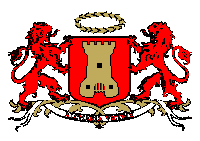 Alkmaar,
town, western Netherlands, in North Holland Province, on the North Holland Canal,
near Amsterdam. It is a trading center for cattle,
corn, and dairy products; cheese is a major export and the town is famous for
its cheese market. First mention of Alkmaar is in the 10th century in the description
of a gift by Count Dirk I to the abbey of Egmond. Count Floris V granted city
rights in 1254. In 1573 the town successfully withstood a Spanish siege. In
October 1799, during the Napoleonic Wars, the commander in chief of the Anglo-Russian
army in the Netherlands signed the French terms of capitulation in Alkmaar.
Population (2000 estimate) 93,000.
Alkmaar,
town, western Netherlands, in North Holland Province, on the North Holland Canal,
near Amsterdam. It is a trading center for cattle,
corn, and dairy products; cheese is a major export and the town is famous for
its cheese market. First mention of Alkmaar is in the 10th century in the description
of a gift by Count Dirk I to the abbey of Egmond. Count Floris V granted city
rights in 1254. In 1573 the town successfully withstood a Spanish siege. In
October 1799, during the Napoleonic Wars, the commander in chief of the Anglo-Russian
army in the Netherlands signed the French terms of capitulation in Alkmaar.
Population (2000 estimate) 93,000.
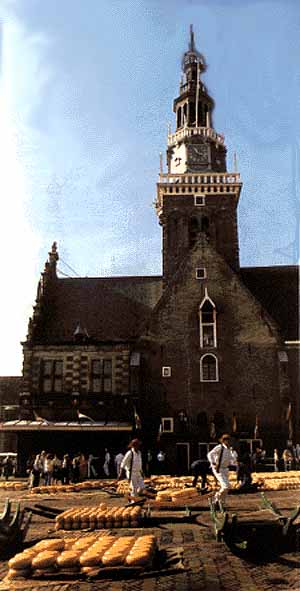 Photo of the Weigh-building
and famous Cheese Market. The Cheese
Market is a show performed every Friday morning during tourist season. It
attracts a large volume of visitors all coming to see a depiction of classical
cheese trade and its associated movement of cheese from seller to buyer.
Photo of the Weigh-building
and famous Cheese Market. The Cheese
Market is a show performed every Friday morning during tourist season. It
attracts a large volume of visitors all coming to see a depiction of classical
cheese trade and its associated movement of cheese from seller to buyer.
More information about Alkmaar
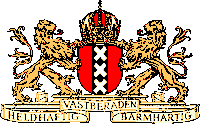 Amsterdam (Netherlands), seaport, constitutional capital, and principal city,
western Netherlands, in North Holland Province, on the IJ (an arm of the
IJsselmeer), near The Hague. The real seat of national government, however, is in
The Hague. Amsterdam is divided by canals into about 90 islands joined by about
400 bridges. Almost the entire city rests on a foundation of piles driven through
peat and sand to a firm substratum of clay.
Amsterdam (Netherlands), seaport, constitutional capital, and principal city,
western Netherlands, in North Holland Province, on the IJ (an arm of the
IJsselmeer), near The Hague. The real seat of national government, however, is in
The Hague. Amsterdam is divided by canals into about 90 islands joined by about
400 bridges. Almost the entire city rests on a foundation of piles driven through
peat and sand to a firm substratum of clay.
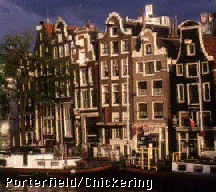
Commerce
Amsterdam is one of the most important commercial centers in Europe. The city is
a major port linked to the North Sea and other European countries by a network of
railways and canals, notably the North Sea Canal, which is navigable by
oceangoing vessels. Among leading industries in the city are shipbuilding, sugar
refining, publishing, and the manufacture of heavy machinery, paper products,
textiles and clothing, porcelain and glass, aircraft, automobiles, and chemicals.
The city is also famous as a center for polishing and cutting diamonds and as the
chief financial center of the Netherlands. A major European stock exchange is
located in Amsterdam, as are the Bank of the Netherlands and several insurance
firms.
Cultural Life
Amsterdam has been an important center of European cultural life since the 17th
century. The city is the site of the National Academy of Art, the Royal
Netherlands Academy of Sciences, and the University of Amsterdam (1632). Its
Rijksmuseum contains one of the largest collections of Dutch and Flemish
paintings in the world, and its Stedelijk Museum has an extensive collection of
modern works. Amsterdam is also noted as the home of the renowned painter
Rembrandt; his home is now a museum. The city has numerous examples of 16th- and
17th-century architecture, as well as two historic churches: Oude Kerk (Old
Church), built about 1300, and Nieuwe Kerk (New Church), built in the 15th
century. The royal palace, originally built in the 17th century as the town hall,
stands on a large square in the center of the city.
History
Amsterdam, chartered as a city in 1300, became a member of the Hanseatic League
in 1369. In the 17th century, after the successful conclusion of the Dutch wars
for independence from Spain, Amsterdam became the chief commercial center of
northern Europe. The city held this position until the late 18th century, when
trade declined as a result of the silting of the Zuider Zee and the British
blockade before and during the Napoleonic Wars. In 1810 Napoleon incorporated the
Netherlands into the French Empire, but after his downfall the Netherlands
regained its independence and Amsterdam was made the official capital of the
country. In the latter part of the 19th century, commercial activities revived
with the opening of the North Sea and North Holland canals. During World War II,
Amsterdam was occupied by the German army for five years. The people suffered
great hardship and the port was badly damaged, but it has since been rebuilt and
improved. Population (1988 estimate) 691,700.
More information about Amsterdam
The Hague (Dutch 's Gravenhage, or Den Haag), seat of the government of
the Netherlands (Amsterdam is the official capital), and capital of South Holland
Province, in the western part of the country. Located about 6 km (about 4 mi)
inland from the North Sea, it is the nation's third largest city and its chief
administrative center. the Supreme Court of the Netherlands and the
States-General (parliament) are here; the city is also the site of most foreign
embassies. Integral parts of the surrounding metropolitan area include the famous
beach resort of Scheveningen; Wassenaar, known for its tree-lined avenues and
luxurious residences; and Rijswijk, Voorburg, and the new town of Zoetermeer.
The Hague is mainly residential, its economy based largely on government and
administrative activities. the city is the site of the International Court of
Justice, a United Nations agency, and is increasingly important as a center for
international conferences. It is also an important transportation center with
major highways, railroads, and canals providing access to Rotterdam and
Amsterdam. Offices of Royal Dutch Shell and other major corporations are here.
Diversified manufactures, produced at scattered locations throughout the
metropolitan area, include the following: electronic equipment, metal products,
chemicals, glass, printed materials, and chocolate and other processed food.
Points of Interest
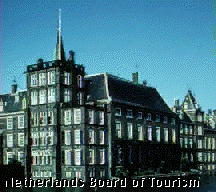 Notable landmarks in The Hague include the Binnenhof (inner court) and Buitenhof
(outer court), consisting of a group of government structures dating in part from
the 13th century. These include the palace of the States-General, the courts of
justice, and the Ridderzaal (Hall of the Knights), built in 1252, in which the
states of the Netherlands repudiated the sovereignty of Philip II, king of Spain,
in 1581. Ancient towers and gateways surround the group. Nearby to the north is
the city's main square and the famous Mauritshuis Royal Art Gallery, known for
its collection of 15th- to 17th-century Dutch paintings. Other historic landmarks
include the 15th-century Groote Kerk (Great Church); the Stadhuis (City Hall,
1565); and the Gevangenpoort (Prison Gate), now a museum, where the Dutch
statesmen Jan De Witt and Cornelis De Witt were murdered in 1672. Modern
buildings of interest are the Peace Palace (1913), endowed by the American
industrialist and philanthropist Andrew Carnegie in 1903 and now the home of the
International Court of Justice; the modern Municipal Building; and the
Netherlands Congress Center (1969). Educational institutions in The Hague include
the Institute of Social Studies (1952), the Royal Conservatory of Music and Dance
(1826), and the Royal Academy of Fine and Applied Arts (1682). Madurodam, a
miniature reconstruction of an old Dutch town, is a popular tourist attraction.
Notable landmarks in The Hague include the Binnenhof (inner court) and Buitenhof
(outer court), consisting of a group of government structures dating in part from
the 13th century. These include the palace of the States-General, the courts of
justice, and the Ridderzaal (Hall of the Knights), built in 1252, in which the
states of the Netherlands repudiated the sovereignty of Philip II, king of Spain,
in 1581. Ancient towers and gateways surround the group. Nearby to the north is
the city's main square and the famous Mauritshuis Royal Art Gallery, known for
its collection of 15th- to 17th-century Dutch paintings. Other historic landmarks
include the 15th-century Groote Kerk (Great Church); the Stadhuis (City Hall,
1565); and the Gevangenpoort (Prison Gate), now a museum, where the Dutch
statesmen Jan De Witt and Cornelis De Witt were murdered in 1672. Modern
buildings of interest are the Peace Palace (1913), endowed by the American
industrialist and philanthropist Andrew Carnegie in 1903 and now the home of the
International Court of Justice; the modern Municipal Building; and the
Netherlands Congress Center (1969). Educational institutions in The Hague include
the Institute of Social Studies (1952), the Royal Conservatory of Music and Dance
(1826), and the Royal Academy of Fine and Applied Arts (1682). Madurodam, a
miniature reconstruction of an old Dutch town, is a popular tourist attraction.
History
The Hague originated as a hunting seat of the counts of Holland. It became the
center of court life after William of Holland built a castle here in 1248, and in
the late 16th century the city emerged as the Dutch capital during the revolt of
the Netherlands against Spanish rule. It was under French control from 1795 to
1813 and again became the center of court life in 1815 with the establishment of
the kingdom of the United Netherlands, which included present-day Belgium until
1830. The Hague Peace Conferences of 1899 and 1907 (see: Hague Conferences)
increased the city's longstanding importance as an international diplomatic and
judicial center and led to the establishment here of the Hague Tribunal, or
Permanent Court of Arbitration. Since the early 1970s efforts have been made to
relocate some of the city's governmental functions to less developed outlying
provinces. Population (1988 estimate) 444,300.
More information about The Hague
Back to Netherlands & Alkmaar page.
“Netherlands” Microsoft® Encarta. Copyright © 1995 Microsoft Corporation. Copyright © 1998-2010 Dolf
Starreveld
Page last updated:
Saturday, February 17, 2018
 Alkmaar,
town, western Netherlands, in North Holland Province, on the North Holland Canal,
near Amsterdam. It is a trading center for cattle,
corn, and dairy products; cheese is a major export and the town is famous for
its cheese market. First mention of Alkmaar is in the 10th century in the description
of a gift by Count Dirk I to the abbey of Egmond. Count Floris V granted city
rights in 1254. In 1573 the town successfully withstood a Spanish siege. In
October 1799, during the Napoleonic Wars, the commander in chief of the Anglo-Russian
army in the Netherlands signed the French terms of capitulation in Alkmaar.
Population (2000 estimate) 93,000.
Alkmaar,
town, western Netherlands, in North Holland Province, on the North Holland Canal,
near Amsterdam. It is a trading center for cattle,
corn, and dairy products; cheese is a major export and the town is famous for
its cheese market. First mention of Alkmaar is in the 10th century in the description
of a gift by Count Dirk I to the abbey of Egmond. Count Floris V granted city
rights in 1254. In 1573 the town successfully withstood a Spanish siege. In
October 1799, during the Napoleonic Wars, the commander in chief of the Anglo-Russian
army in the Netherlands signed the French terms of capitulation in Alkmaar.
Population (2000 estimate) 93,000. Photo of the Weigh-building
and famous Cheese Market. The
Photo of the Weigh-building
and famous Cheese Market. The  Amsterdam (Netherlands), seaport, constitutional capital, and principal city,
western Netherlands, in North Holland Province, on the IJ (an arm of the
IJsselmeer), near The Hague. The real seat of national government, however, is in
The Hague. Amsterdam is divided by canals into about 90 islands joined by about
400 bridges. Almost the entire city rests on a foundation of piles driven through
peat and sand to a firm substratum of clay.
Amsterdam (Netherlands), seaport, constitutional capital, and principal city,
western Netherlands, in North Holland Province, on the IJ (an arm of the
IJsselmeer), near The Hague. The real seat of national government, however, is in
The Hague. Amsterdam is divided by canals into about 90 islands joined by about
400 bridges. Almost the entire city rests on a foundation of piles driven through
peat and sand to a firm substratum of clay.
 Notable landmarks in The Hague include the Binnenhof (inner court) and Buitenhof
(outer court), consisting of a group of government structures dating in part from
the 13th century. These include the palace of the States-General, the courts of
justice, and the Ridderzaal (Hall of the Knights), built in 1252, in which the
states of the Netherlands repudiated the sovereignty of Philip II, king of Spain,
in 1581. Ancient towers and gateways surround the group. Nearby to the north is
the city's main square and the famous Mauritshuis Royal Art Gallery, known for
its collection of 15th- to 17th-century Dutch paintings. Other historic landmarks
include the 15th-century Groote Kerk (Great Church); the Stadhuis (City Hall,
1565); and the Gevangenpoort (Prison Gate), now a museum, where the Dutch
statesmen Jan De Witt and Cornelis De Witt were murdered in 1672. Modern
buildings of interest are the Peace Palace (1913), endowed by the American
industrialist and philanthropist Andrew Carnegie in 1903 and now the home of the
International Court of Justice; the modern Municipal Building; and the
Netherlands Congress Center (1969). Educational institutions in The Hague include
the Institute of Social Studies (1952), the Royal Conservatory of Music and Dance
(1826), and the Royal Academy of Fine and Applied Arts (1682). Madurodam, a
miniature reconstruction of an old Dutch town, is a popular tourist attraction.
Notable landmarks in The Hague include the Binnenhof (inner court) and Buitenhof
(outer court), consisting of a group of government structures dating in part from
the 13th century. These include the palace of the States-General, the courts of
justice, and the Ridderzaal (Hall of the Knights), built in 1252, in which the
states of the Netherlands repudiated the sovereignty of Philip II, king of Spain,
in 1581. Ancient towers and gateways surround the group. Nearby to the north is
the city's main square and the famous Mauritshuis Royal Art Gallery, known for
its collection of 15th- to 17th-century Dutch paintings. Other historic landmarks
include the 15th-century Groote Kerk (Great Church); the Stadhuis (City Hall,
1565); and the Gevangenpoort (Prison Gate), now a museum, where the Dutch
statesmen Jan De Witt and Cornelis De Witt were murdered in 1672. Modern
buildings of interest are the Peace Palace (1913), endowed by the American
industrialist and philanthropist Andrew Carnegie in 1903 and now the home of the
International Court of Justice; the modern Municipal Building; and the
Netherlands Congress Center (1969). Educational institutions in The Hague include
the Institute of Social Studies (1952), the Royal Conservatory of Music and Dance
(1826), and the Royal Academy of Fine and Applied Arts (1682). Madurodam, a
miniature reconstruction of an old Dutch town, is a popular tourist attraction.